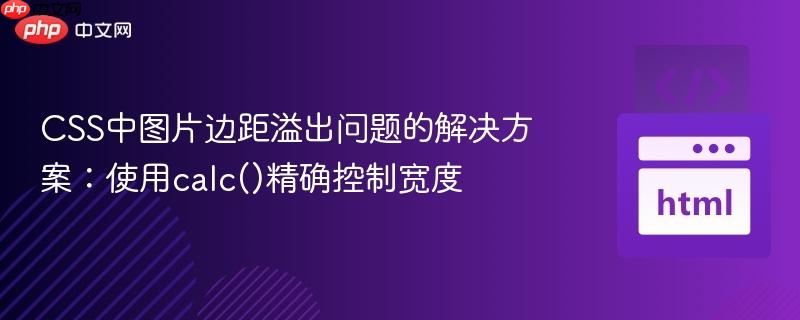
本文深入探讨了在固定宽度容器内为图片设置边距时,图片可能溢出容器的问题。通过分析css盒模型和默认行为,我们揭示了溢出的原因,并提供了一种基于`calc()`函数的精确解决方案,确保图片在包含边距的情况下也能完美适应容器宽度,从而实现响应式且无溢出的布局。
在网页布局中,我们经常需要为图片设置边距(margin)以调整其在容器内的位置。然而,一个常见的困扰是,当在一个具有固定宽度的父容器(如div)内为图片设置边距时,图片可能会溢出容器的边界,尤其是在底部和右侧。这通常发生在图片默认的宽度行为与我们期望的布局发生冲突时。
考虑以下场景:我们有一个固定宽度为375px的div容器,其中包含一张图片。我们希望为这张图片添加10px的边距,使其在容器内部留有空白。
HTML结构示例:
<div class="tile"> @@##@@ <!-- 其他内容 --> </div>
原始CSS样式:
立即学习“前端免费学习笔记(深入)”;
.tile {
background-color: hsl(0, 0%, 100%);
margin: auto;
text-align: center;
width: 375px; /* 父容器固定宽度 */
}
.tile img {
margin: 10px; /* 为图片添加10px边距 */
}问题分析:
当上述CSS应用后,图片会显示在div中,但其左右和底部的10px边距可能会导致图片溢出父容器。这是因为:
为了解决这个问题,我们需要确保图片的内容宽度能够动态调整,使其加上左右边距后正好等于父容器的宽度。CSS的calc()函数是实现这一目标的理想工具。
calc()函数允许我们在CSS属性值中执行数学计算。通过它,我们可以将百分比、像素值等不同单位混合使用,实现更灵活的布局。
核心CSS代码:
.tile img {
margin: 10px; /* 设置边距 */
width: calc(100% - 20px); /* 动态计算图片宽度以适应边距 */
}解释:
以下是一个完整的HTML和CSS示例,展示了如何应用calc()来解决图片边距溢出问题:
HTML (保持不变):
<!DOCTYPE html>
<html lang="en">
<head>
<meta charset="UTF-8">
<meta name="viewport" content="width=device-width, initial-scale=1.0">
<title>Frontend Mentor | QR code component</title>
<link rel="icon" type="image/png" sizes="32x32" href="./images/favicon-32x32.png">
<style>
body {
background-color: hsl(212, 45%, 89%);
display: flex; /* 使用Flexbox或Grid居中 */
justify-content: center;
align-items: center;
min-height: 100vh; /* 确保body至少占满视口高度 */
margin: 0;
font-family: sans-serif; /* 示例字体 */
}
.tile {
background-color: hsl(0, 0%, 100%);
border-radius: 15px; /* 添加圆角 */
text-align: center;
width: 375px; /* 父容器固定宽度 */
padding: 15px; /* 增加一些内边距,使内容不紧贴边缘 */
box-shadow: 0 10px 20px rgba(0,0,0,0.1); /* 添加阴影效果 */
}
.tile img {
margin: 10px; /* 设置边距 */
width: calc(100% - 20px); /* 动态计算图片宽度以适应边距 */
display: block; /* 确保图片独占一行,消除下方空白 */
border-radius: 10px; /* 图片圆角 */
}
.tile h2 {
font-size: 22px;
color: hsl(218, 44%, 22%);
margin-top: 20px;
margin-bottom: 10px;
}
.tile p {
font-size: 15px;
color: hsl(220, 15%, 55%);
padding: 0 10px 20px; /* 底部增加内边距 */
line-height: 1.5;
}
.attribution {
position: absolute;
bottom: 10px;
width: 100%;
text-align: center;
font-size: 11px;
color: hsl(228, 45%, 44%);
}
.attribution a {
color: hsl(228, 45%, 44%);
text-decoration: none;
}
</style>
</head>
<body>
<div class="tile">
@@##@@
<h2>Improve your front-end skills by building projects</h2>
<p>Scan the QR code to visit Frontend Mentor and take your coding skills to the next level</p>
</div>
<div class="attribution">
Challenge by <a href="https://www.frontendmentor.io?ref=challenge" target="_blank">Frontend Mentor</a>.
Coded by <a href="#">Joshua</a>.
</div>
</body>
</html>CSS (关键部分已更新):
在上述HTML的
在固定宽度容器内为图片添加边距并避免溢出是一个常见的CSS布局挑战。通过深入理解CSS盒模型和元素默认行为,并巧妙地利用calc()函数动态计算图片宽度,我们可以精确地控制图片在容器内的尺寸,确保其在包含边距的情况下也能完美适应容器。这种方法不仅解决了溢出问题,也为构建更灵活、更具响应性的网页布局提供了强大的工具。


以上就是CSS中图片边距溢出问题的解决方案:使用calc()精确控制宽度的详细内容,更多请关注php中文网其它相关文章!

每个人都需要一台速度更快、更稳定的 PC。随着时间的推移,垃圾文件、旧注册表数据和不必要的后台进程会占用资源并降低性能。幸运的是,许多工具可以让 Windows 保持平稳运行。

Copyright 2014-2025 https://www.php.cn/ All Rights Reserved | php.cn | 湘ICP备2023035733号